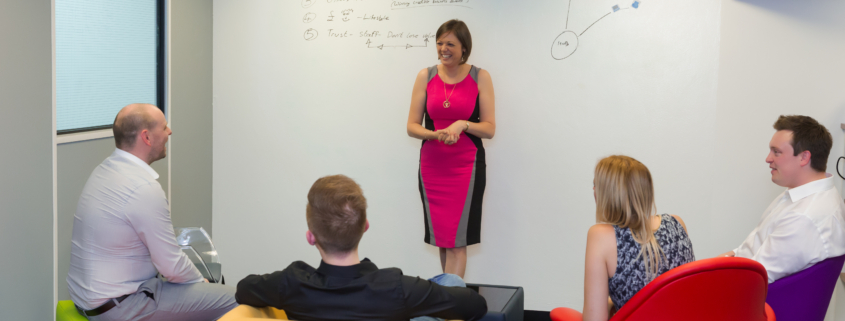When I began the Strategic Leadership course I was conscious that as the Co-Founder and CEO of my organisation, my strengths and weaknesses as an individual were embedded in our company culture. Work with the team and an external consultant had identified our organisation ‘the person’ as a mix between Elvira the Princess of Darkness (a computer game character from the 1990s) and Steve Jobs. The words that came up to describe our strengths were ‘trailblazer’, ‘doing things differently’, ‘independent thinkers’. Our weaknesses: ‘lack of support’, ‘we don’t listen to each other’, ‘pulling in different directions’.
Using Bolman and Deal’s (2015) frames of leadership, I spent most of my time looking through the political frame as a warrior in the jungle. While this attitude had got the business off the ground and to the £1m turnover mark organically after just 5 years, I knew it was not what the organisation needed moving forward. I felt I was holding the company back because I was not embracing all the different frames of leadership. My perception of leadership was very strongly linked to the role of the individual leader: the person with the position and the title. However, it was not the title alone that commanded credibility for me. The leader also had to be inspirational to be credible. For me, great leaders were those who inspired people to follow them. Great leaders instinctively knew what was best for their followers because followers did not know what was best for themselves. Sunstein and Thaler (2008) introduce us to libertarian paternalism which I identified with as the kind of leader I believed I was and would continue to be. I started the course believing I would complete it and go back having learnt a strong set of inspirational ‘nudge’ techniques. I would inspire our management team to be great leaders by being an even greater leader. I would show them how to be supportive and nurturing by being even more supportive and nurturing. They would learn by following me and become better by adopting my changed behaviours. However, I would always be one step ahead because I was ‘better’. I would remain at the top of the organisational tree for others to look up to.
What does it mean to be inspirational? We hear the word used frequently to describe the leaders Badaracco (2002) identifies at the top of the “heroic leadership” pyramid, which is where I saw myself:
They have clear, strong values and know right from wrong. They act boldly, sacrifice themselves for noble causes, set compelling examples for others, and ultimately change the world
(Badaracco, 2002: 2)
I loved reading that. Yes, I thought, that is me. However, I did not enjoy reading about those at the bottom of the pyramid. As an English Literature graduate Badaracco’s use of TS Eliot’s ‘hollow men’ shocked me. He is clear on the heroic pyramid model: those at the bottom are “life’s bystanders, shirkers, and cowards” (Badaracco, 2002: 2). This is not my view of the world. This is not my view of our team. Those at the bottom of our company pyramid work hard. They are the front-line for our customers. They are the people I frequently receive emails about praising their dedication to the company, their excellent levels of service, their initiative and sense of responsibility. I know these people personally. They have difficult lives. Single parents; carers for disabled relatives; struggling with mental illness. These people are not shirkers or cowards. They are hard-working and courageous. I realised reading Badaracco that they know what is best for them because they know their lives more intimately than I do. I am not at the top of their tree. We all have our own tree to climb at different paces with different branches to use.
On the first day of the course at Warwick Business School, I was instantly drawn to the Lao Tsu quote as it hung on the wall:
A leader is best when people barely know he exists,
when his work is done, his aim fulfilled, they will say: we did it ourselves.
I have a very strong personal reaction every time I read this quote. I feel physically warm. I feel calm and I feel present. I feel understood. This is the person I am inside. The natural way for me to lead. Reading the quote, I believed it would be easy from there on. I had identified that our team knew what was best for themselves. I had identified that I wanted to be a leader who silently enabled and empowered others to be great. Yet awareness is only the first step to change. While I was able to see and understand in the classroom away from the world, after returning to work for barely a day I had fallen back into my old ‘top of the tree’ habits. I would start with Sunstein and Thaler’s (2008) libertarian paternalistic approach of ‘do things my way because I know what is best for you’; but if all else failed I had the ‘this is my business’ card to play for the trickier members of the management team. I realised sadly a week or so after being back to work, when I had told our Technical Director exactly how much money the business still owed me personally, that there are countless layers of conditioning standing between my current self and the quote that means so much to me. I could see the gulf between the leader I was and the one I wanted to be. My conditioning was binding me tightly to my perception of myself as leader. My conditioning was holding me back from adopting Lao Tsu’s silent, serving style of leadership. After the first two modules, my immediate reflections on the course were how hard it had been. It had been hugely challenging and tiring. I became constantly conscious of the lead weights I was carrying around that kept me on Heifetz and Laurie’s (1997) dance floor and prevented me from reaching the balcony.
What are my lead weights? Stripping all the complexity away there are two main ones and they are best described using Freud’s (1923) ego and id. First the ego. I am called inspirational. I like it and it is addictive. Somewhere in my past my sense of self value has been bound to this ideal of being an inspiration to others. Being the one who sees in others what they don’t see in themselves and the one who pushes them to achieve that potential. My ego seeks to control others as I identify the steps they need to take to achieve the goals I set for them. My conscience makes her peace with this controlling behaviour because it is ‘for their own good’. I’m acting the role of libertarian paternalist. What about the flip side? My id or inner child. As my ego wants to inspire and control; my id wants to be inspired and controlled. It wants someone else to tell me what to do to achieve my potential. My id wants to find my own libertarian paternalist who knows what is best for me. When I listen to those in the position of leader I want to be inspired and when I am not I feel bereft. If I don’t get what I seek I feel the figure positioned as leader has let me down. My reaction to this is irrationally strong when analysed. Examining these feelings objectively for this assignment, I am drawn to the situations with Nick during the Strategic Leadership sessions. Our discussions angered me and my Learning Journals were accusatory in tone. My reaction was highly emotional. I felt he had let me down by positioning himself at the front of the classroom as leader and not providing me with the inspiration I craved. The accepted evidence of his credibility as leader was clear: his title in Warwick Business School, his experience, his position at the front of the classroom. He had control of the room. If he told us to jump up and down for 60 seconds, we would unquestioningly have obeyed. He appeared to me as the libertarian paternalist. I believed he had all the answers I sought. He knew what was best for me and seemingly refused to tell me. My id was angry that he would leave us scrambling around on the dance floor for the shreds of his knowledge he chose to drop down from the balcony. Now I realise he was inviting us up to join him. He could not force us to leave the dance floor; so he was on the balcony opening the door and showing us the staircase.
To reach the balcony, I need to free myself of the ego and id lead weights that hold me back. One way to free myself is to adopt Bolman and Deal’s approach of looking through “multiple lenses” (Bolman & Deal, 2015: 39). To illustrate this, I want to use the example of my youngest sister who came to work for the organisation in 2013 having worked as a hairdresser since she left school at 16. She is now in her 30s. I name her as my sister to show you the desire for me to be the libertarian paternalist (Sunstein & Thaler, 2008) was even stronger than usual. She wanted more flexibility in her work for her family and, after watching her struggle for a year to secure an office position without having any relevant experience, I offered her a part-time role. It was a risk to her and the business. I vowed to make it work and adopted the ‘sink or swim’ attitude to her development. However, after a few months I started to see her sink. I pulled her out and started again but I did not change my approach. In retrospect, I failed to recognise this was an adaptive challenge calling for collective intelligence and not one I would solve alone (Heifetz & Laurie, 1997: 126). I remember one very emotional conversation between the two of us after 12 months of her working full-time when I realised and accepted I did not know what was best to move her forward anymore. I had hit a wall. I contacted our business coach and arranged for her to spend some time with him having 1 to 1 support. I remember telling him “I can’t help her anymore.” Now, she’s Operations Manager of the Communications division with her own direct reports and liaising with the IT Operations Manager, the Technical Director, the MD, and myself. There are multiple ways to tell this story if we adopt multiframe thinking (Bolman & Deal, 2015). My sister reinforces the way my ego wants to tell it. “You saw something in me I didn’t see” she says, “you made me what I am.” However, through another frame we can see she did it for herself. I created the environment for her to grow. I was there to support her growth with resources like financial investment and training. But she did the growing. She knew what was best for her and I helped her to find it.
I don’t believe I can eradicate my ego. Dr Stephen Covey (2002) highlights in his introduction to Greenleaf’s Servant Leadership when he says the ego is “selfishly ambitious. [It] focuses on one’s own survival, pleasure, and enhancement to the exclusion of others” (Covey, 2002: 12) If I can’t eradicate the ego and its selfish focus, can I channel her energy in a more productive way? I believe I can. I can educate my ego to accept the only growth I control is my own. I can be “selfishly ambitious” in my demands on myself to be the best I can be. What is it I want from this life? What is my purpose? I have always liked George Bernard Shaw’s (c.1930) take on this question:
This is the true joy in life, the being used for a purpose recognised by yourself as a mighty one …
I want to be thoroughly used up when I die, for the harder I work the more I live
I ask myself Greenleaf’s (1977) probing question “How can I use myself to serve best?” because to serve the world is certainly a purpose recognised by me as a mighty one. I can align my ego with this purpose. I can allow her the private joy of knowing I have played an integral part in the creation of beautiful things. As Hermann Hesse (1932) tells us in The Journey to the East “We had talked about the creations of poetry being more vivid and real than the poets themselves”. Nothing appeals to the ego more than the concept of legacy and the thought of being remembered forever in that which we have created. Our creations remain long after our bodies are nothing but dust.
What else can I do to free myself of my lead weights especially that of my id? That inner child who desperately seeks inspiration and feels bereft when she doesn’t receive it. I can provide inspiration for her. I can provide peace. If I look hard at the places I find peace currently in my life they are an eclectic mix. I have never meditated but this year I took up life modelling as my new hobby for 2016. This involves posing nude for a room full of artists. Some are classes for budding artists and others are studio sessions for established painters. It is the closest I have ever got to mindfulness to date. I have to empty my mind. I have to focus on the pose I am holding, which is not uncomfortable, but does require concentration. Every sensation is heightened. Sounds are clearer. Colours are brighter. I notice temperature changes. I feel calm and still. Both my ego and id are happy here because I am the focus of attention. The class would not happen without me. While it brings me peace; it does not help me break my dependency on being the one who inspires others. What else is there? I like to run. I am not naturally athletic so it is certainly something I have to motivate myself for but it is only me and the road and no one will know if I do well or not except me. Before I go out, I set myself a goal, either time or distance, and I always reach it. I notice when my emotional energy kicks in. I enjoy the rush it brings. I am both the inspirer and the inspired! I also love to write. Blogs, poetry, and currently my first novel. My creations are certainly more vivid and real than myself and in them my id finds her inspiration.
Recognising my style of leadership as rooted in my ego and id allows me to climb the stairs to the balcony. From there I see that I am no longer synonymous with my company. The business is a living breathing institution of its own with its own purpose, values, and desires to fulfil. I do not know what is best for the company. It knows what is best for itself. As Greenleaf tells us, love the people “who are gathered to render the service for which the corporation is enfranchised. The people are the institution” (Greenleaf, 1977: 118 [his italics]). Up here on the balcony I am able to start Karl Weick’s (2007) process of sense-making. Does our organisation need a leader? The company knows what is best for itself and I know what is best for me, so where do I place myself to best serve? The business needs new sales and has a relatively young and inexperienced sales team. Sales is my background and where my strengths of communication and intuition are most beneficial operationally. With this in mind, I have moved into an interim role of Sales Director three days per week: hosting conference calls bi-weekly, tracking opportunities, supporting on identifying and scoping prospects. Here I feel I occupy an interim position. I play both roles of “administrator of day to day operations” and the “manager of a process” (Greenleaf, 1977: 130). This is what the business needs most from me right now.
On the balcony I am able to see beyond that. I am able to see the purpose recognised by me as a mighty one. To empower people to reach their potential. To serve them to the best of my ability on that journey and provide them with the resources they need. Like my sister. She did not flourish by being dependent on my inspiration. She flourished by inspiring herself with my support. Robert Greenleaf (1977) makes a plea to businesses to change their ethic. “What are you in business for?” he asks and the answer he hopes for in return “I am in the business of growing people – people who are stronger, healthier, more autonomous, more self-reliant, more competent” (Greenleaf, 1977: 127) Greenleaf made this challenge to American corporations in the 1970s but it is the British scale-ups I believe who are truly embracing it. I see servant-leadership in action in businesses around me and it encourages me to embrace it too. Not because I want to be seen as a great and heroic leader but because it is what I am called to do. “We all serve,” says Greenleaf, “one way that some people serve is to lead” (Greenleaf, 1977: 120).
Inspirational leaders at the top of Badaracco’s (2002) pyramid rely on the cycle of inspirational dependency and I have learnt it is a cycle which traps both leader and follower. Leader inspires; Followers follow; Leader recognises he/she cannot achieve goals without Followers; Followers need Leader to continue to inspire in order to continue following; Leader feels compelled to continue to inspire or he/she will fail. Breaking this cycle of dependency will continue to be a challenge for me in the short term but I will strive every moment to achieve it for my mighty purpose. Because the harder I serve, the more I live.
Sarah Windrum. Warwick Business School. Postgraduate Award in Strategic Leadership & Change Management
Bibliography
Bolman, Lee G. & Deal, Terrence E. (2015) Think or Sink: Leading in a VUCA World. Leader to Leader, 76: 35-40.
Sunstein, Cass R. & Thaler, Richard H. (2008) Nudge: Improving Decisions about Health, Wealth, and Happiness. Yale University Press.
Badaracco, Joseph L. (2002) Leading Quietly: An Unorthodox Guide to Doing the Right Thing. Harvard Business School.
Heifetz, Ronald A. & Laurie, Donald L. (1997) The Work of Leadership. Harvard Business Review 124-134.
Freud, Sigmund. (1923) The Ego & the Id. International Psycho-Analytical Library, 12 [Translated by Joan Riviere, edited by James Strachey 1974 Revised Edition]
Greenleaf, Robert K. (1977) Servant Leadership: A Journey into the Nature of Legitimate Power and Greatness. New York [2002 edition: Foreword by Dr Stephen Covey]
Shaw, George Bernard (c.1930) A Splendid Torch. The Collected Works of Bernard Shaw [online]
Hesse, Hermann (1932) The Journey to the East. [online 2011 edition]
Weick, Karl (2007) Drop your Tools: On Reconfiguring Management Education. The Journal of Management Education, 31: 5-16.





 Sarah Windrum
Sarah Windrum 



Leave a Reply
Want to join the discussion?Feel free to contribute!